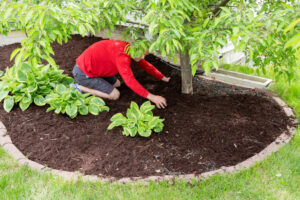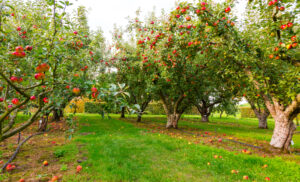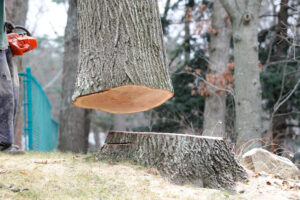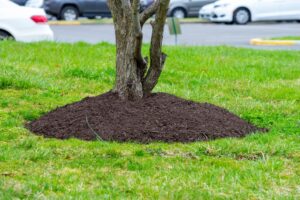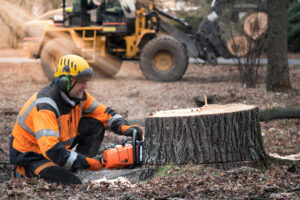Trees are silent companions, standing tall and firm, weathering storms and heatwaves alike. They are the unsung heroes of our landscapes, providing shade, beauty, and a home for wildlife. Yet, they are often taken for granted, their needs overlooked until a storm reveals a dangling branch or a disease leaves a visible mark.
Tree maintenance, however, is not a luxury—it’s a necessity. It’s not just about preserving the aesthetic appeal of your property; it’s about ensuring the safety of your home and the health of your trees. It’s about understanding that trees, like any living organism, require care and attention to stay healthy and thrive.
But why is tree maintenance so important?
As a native of the Tri Cities Tennessee region, you’ve likely witnessed the damage that extreme weather can cause. Torrential rains, heavy winds, and even pests can wreak havoc on trees. Yet, with regular maintenance, you can prepare your trees to withstand these challenges.
Even in the absence of weather disruptions, certain trees are more vulnerable to disease or pests. Regular inspections can help identify any signs of disease or pest infestation early on, allowing for timely treatment.
Moreover, it can take several decades for trees to reach maturity. Protecting the ones you already have is not just a matter of convenience—it’s a matter of environmental responsibility.
Table : Key Benefits of Tree Maintenance: A Statistical Overview
| Benefit of Tree Maintenance | Statistic | Source |
|---|---|---|
| Carbon Dioxide Absorption | One acre of forest absorbs six tons of CO2 annually | U.S. Department of Agriculture |
| Oxygen Production | One acre of forest produces enough oxygen for 18 people annually | U.S. Department of Agriculture |
| Property Value Increase | Healthy, mature trees add an average of 10% to a property’s value | U.S. Forest Service |
| Energy Savings | Strategically placed trees save up to 56% on annual air-conditioning costs | USDA Forest Service |
| Health Perception Improvement | Having 10 more trees in a city block improves health perception comparably to an increase in annual personal income of $10,000 | Landscape and Urban Planning Journal |
In the following sections, we’ll delve deeper into the key aspects of tree maintenance, providing practical tips and insights from the field. We’ll discuss everything from the art and science of pruning to the hidden world of tree diseases and pests, the unsung hero of tree health—soil, and much more.
Pruning: Techniques and Benefits
Pruning is not just about snipping away branches. It’s a delicate balance of understanding the tree’s growth patterns, its species-specific needs, and the impact of each cut. It’s about knowing when to prune, where to make the cut, and how much to remove.
Pruning is essential for several reasons. Firstly, it helps maintain the tree’s shape, enhancing its natural form and beauty. Secondly, it promotes healthy growth by removing dead, diseased, or damaged branches, allowing the tree to direct its energy towards new growth.
But perhaps most importantly, pruning plays a crucial role in ensuring safety. Overgrown or weak branches can pose a risk, especially during storms or high winds. By removing these potential hazards, pruning helps protect your property and the people around it.
However, improper pruning can do more harm than good. Over-pruning can stress the tree, leaving it vulnerable to diseases or pests. Cuts made in the wrong place can lead to decay, affecting the tree’s overall health and longevity. That’s why it’s essential to understand the art and science of pruning or to seek help from professionals like Tri Cities Tree Guy.
Identifying and Managing Tree Diseases and Pests
Trees, in their silent strength, are often seen as invincible. But beneath their sturdy bark and lush foliage, they can be fighting a constant battle against diseases and pests.
From fungal infections to insect infestations, trees face a myriad of threats. Some diseases cause visible symptoms like discolored leaves or deformed growth, while others may remain hidden until the tree’s health significantly deteriorates.
Pests, too, can cause extensive damage. They can defoliate a tree, weaken its structure, and in severe cases, even lead to its death.
Regular tree maintenance can help detect these issues early on. By inspecting the tree’s bark, leaves, and overall health, you can spot signs of disease or pest infestation. Once identified, these issues can be managed effectively, preventing further damage and helping the tree recover.
However, it’s not just about treating the symptoms. It’s about understanding the underlying causes, whether it’s environmental stress, poor nutrition, or inadequate care. By addressing these root causes, you can not only treat but also prevent tree diseases and pests.
Soil Quality and Its Impact on Tree Health
When we think of tree health, we often focus on the visible parts—the leaves, branches, and trunk. But the real hero lies beneath the surface: the soil.
Soil is more than just a medium for root growth. It’s a dynamic ecosystem, teeming with microorganisms, providing nutrients, and regulating water. The health of a tree is deeply rooted in the quality of the soil it grows in.
Regular soil testing can provide valuable information about its nutrient content and pH level, enabling you to make necessary adjustments to promote tree health. Whether it’s adding organic matter to improve soil structure, adjusting pH levels to optimize nutrient availability, or implementing proper watering techniques to prevent soil compaction, every measure counts.
Moreover, the soil acts as a buffer, protecting the tree from environmental stress. It regulates temperature, mitigates the impact of heavy rains, and even helps filter out pollutants. By taking care of the soil, you’re not just supporting your trees but also contributing to a healthier environment.
Effective Watering Techniques for Trees
Water is the lifeline of trees. It’s essential for photosynthesis, nutrient transport, and overall growth. But watering trees is not as simple as it may seem. It’s not just about the amount of water, but also the timing and method of watering.
Newly planted trees require more frequent watering as their root systems establish. However, as they mature, their watering needs change. Mature trees prefer deep, infrequent watering, which encourages roots to grow deeper into the soil, enhancing their drought tolerance.
The key to watering trees is to keep the soil moist but not waterlogged. Overwatering can lead to root rot, a condition that can severely damage the tree. On the other hand, under-watering can stress the tree, making it more susceptible to diseases and pests.
Different trees also have different watering needs, depending on their species, age, and the local climate. Understanding these needs and adjusting your watering practices accordingly can significantly improve tree health and longevity.
The Role of Mulching in Tree Health
Mulch is a layer of organic material applied to the surface of the soil. It’s a simple technique, but its benefits for tree health are manifold.
Mulch helps conserve soil moisture, reducing the need for frequent watering. It acts as an insulator, protecting the tree roots from extreme temperatures. It also suppresses weed growth, preventing competition for nutrients.
But perhaps one of the most significant benefits of mulching is its contribution to soil health. As the mulch decomposes, it adds organic matter to the soil, improving its structure and nutrient content. This not only benefits the tree but also supports the myriad of microorganisms that contribute to soil health.
However, proper mulching technique is crucial. A common mistake is piling mulch against the tree trunk, often referred to as a “mulch volcano.” This can trap moisture against the trunk, leading to decay. Instead, mulch should be spread in a donut shape around the tree, leaving a gap around the trunk.
Professional Tree Maintenance: When and Why?
While some aspects of tree maintenance can be handled by homeowners, others require the expertise of professionals. Tasks like pruning large trees, treating diseases, or removing hazardous trees can be complex and risky.
Professional tree maintenance companies offer a range of services, including tree trimming, removal, stump grinding, and brush cleanup. They have the necessary equipment and expertise to handle any tree-related task safely and efficiently.
Indeed, the value of professional tree maintenance services extends beyond the tasks they perform. The true benefit lies in their expertise and wisdom. Professionals are equipped with a wealth of knowledge about tree care, enabling them to offer insightful advice that can guide your tree care decisions. Their trained eyes can identify potential problems at their onset, averting small issues from escalating into significant concerns.
Cost Considerations in Tree Maintenance
Tree maintenance is an investment. There’s a cost involved, whether it’s your time and effort or the fee for professional services. But when you consider the benefits, it’s an investment that pays off.
Regular tree maintenance can prevent costly damage to your property. It can extend the life of your trees, saving you the cost of removal and replacement. It can enhance the aesthetic appeal of your property, potentially increasing its value.
Moreover, trees provide ecosystem services, from carbon sequestration to temperature regulation. By maintaining your trees, you’re contributing to these services, which have significant economic value at the community and global level.
The Long-term Benefits of Tree Maintenance
Tree maintenance is a journey, not a destination. It’s a commitment to the health and well-being of your trees, to the safety of your property, and to the environment. It’s about understanding the needs of your trees and providing them with the care they deserve.
As we’ve explored in this guide, tree maintenance involves various aspects, from pruning and watering to disease management and soil care. Each aspect is crucial, contributing to the overall health and longevity of your trees.
Whether you choose to embark on this journey yourself or seek the help of professionals like Tri Cities Tree Guy, remember that every step you take towards tree maintenance is a step towards a greener, healthier world.

